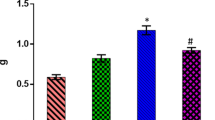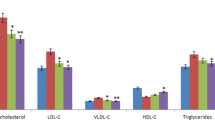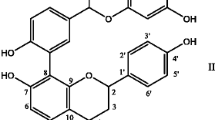Abstract
The present study was aimed to investigate the combined effects of green tea and vitamin E on heart weight, body weight, serum marker enzymes, lipid peroxidation, endogenous antioxidants and membrane bound ATPases in isoproterenol (ISO)-induced myocardial infarction in rats. Adult male albino rats, treated with ISO (200 mg/kg, s.c.) for 2 days at an interval of 24 h caused a significant (P < 0.05) elevation of heart weight, serum marker enzymes, lipid peroxidation and Ca+2 ATPase level whereas there was a significant (P < 0.05) decrease in body weight, endogenous antioxidants, Na+/ K+ ATPase and Mg+2 ATPase levels. Administration of green tea (100 mg/kg/day, p.o.) and vitamin E (100 mg/kg/day, p.o.) together for 30 consecutive days and challenged with ISO on the day 29th and 30th, showed a significant (P < 0.05) decrease in heart weight, serum marker enzymes, lipid peroxidation, Ca+2 ATPase and a significant increase in the body weight, endogenous antioxidants, Na+/K+ ATPase and Mg+2 ATPase when compared with ISO treated group and green tea or vitamin E alone treated groups. These findings indicate the synergistic protective effect of green tea and vitamin E during ISO induced myocardial infarction in rats.
Similar content being viewed by others

References
Rajdurai M, Mainzen Prince S (2007a) Preventive effect of naringin on cardiac markers, electrocardiographic patterns and lysosomal hydrolases in normal and isoproterenol-induced myocardial infarction in Wistar rats. Toxicology 230:178–188 doi:10.1016/j.tox.2006.11.053
Rajdurai M, Mainzen Prince S (2007b) Preventive effect of naringin on isoproterenol-induced cardiotoxicity in Wistar rats: an in vivo and in vitro study. Toxicology 232:216–225 doi:10.1016/j.tox.2007.01.006
Welexer BC (1978) Myocardial infarction in young vs. old male rats: pathophysiological changes. Am Heart J 96:70–80 doi:10.1016/0002-8703(78)90128-X
Mohanty I, Arya DS, Dinda A, Talwar KK, Joshi S, Gupta SK (2004) Mechanisms of cardioprotective effects of Withania somnifera in experimentally induced myocardial infarction. Basic Clin Pharmacol Toxicol 94:184–190
Reto M, Figueira ME, Filipe HM, Almeida CM (2007) Chemical composition of green tea (Camellia sinensis) infusions commercialized in Portugal. Plant Foods Hum Nutr 62:139–144 doi:10.1007/s11130-007-0054-8
Büyükbalci A, El SN (2008) Determination of in vitro antidiabetic effects, antioxidant activities and phenol contents of some herbal teas. Plant Foods Hum Nutr 63:27–33 doi:10.1007/s11130-007-0065-5
Itoh Y, Yasui T, Okada A, Tozawa K, Havashi Y, Kohri K (2005) Preventive effects of green tea on renal stone formation and the role of oxidative stress in nephrolithiasis. J Urol 173:271–275
Papparella I, Ceolotto G, Montemurro D, Antonello M, Garbisa S, Rossi G, Semplicini A (2008) Green tea attenuates angiotensin II induced cardiac hypertrophy in rats by modulating reactive oxygen species production and the src/epidermal growth factor receptor/Akt signaling pathway. J Nutr 139:1596–1601
Xu Y, Ho CT, Amin SG, Han C, Chung FL (1992) Inhibition of tobacco specific nitrosamine induced lung tumorigenesis in A/J mice by green tea and its major polyphenol as antioxidants. Cancer Res 52:3875–3879
Koo SI, Noh SK (2007) Green tea as inhibitor of the intestinal absorption of lipids: Potential mechanism for its lipid lowering effect. J Nutr Biochem 18:179–183 doi:10.1016/j.jnutbio.2006.12.005
Clark MW, Burnett JR, Croft KD (2008) Vitamin E in human health and disease. Crit Rev Clin Lab Sci 45:417–450 doi:10.1080/10408360802118625
Zhou BO, Wu L-M, Yang LI, Liu Z-L (2005) Evidence for alpha tocopherol regeneration reaction of green tea polyphenols in SDS micelles. Free Radic Biol Med 38:78–84 doi:10.1016/j.freeradbiomed.2004.09.023
Zal F, Pour ZM, Vessal M (2007) Comparison of the effects of vitamin E and/or quercetin in attenuating chronic cyclosporine A-induced nephrotoxicity in male rats. Clin Exp Pharmacol Physiol 34:720–724 doi:10.1111/j.1440-1681.2007.04623.x
Anuraj P, Rajamohan T (2003) Cardioprotective effect of tender coconut water in experimental myocardial infarction. Plant Foods Hum Nutr 58:1–12 doi:10.1023/B:QUAL.0000040363.64356.05
Slater TF, Sawyer BC (1971) The stimulatory effect of carbon tetrachloride and other halogenalkane or peroxidative reaction in the rat liver function in vitro. Biochem J 123:805–815
Mishra HP, Fridovich I (1972) The role of superoxide anion in the autooxidation of epinephrine and a simple assay of superoxide dismutase. J Biol Chem 247:3170–3175
Aebi H (1984) Catalase in vivo. Methods Enzymol 105:121–126 doi:10.1016/S0076-6879(84)05016-3
Moron MS, Depierre JW (1979) Levels of glutathione, glutathione reductase and glutathione S transferase activities in rat lung and liver. Biochim Biophys Acta 582:67–78
Rotruck JT, Pope AL, Ganther HE (1979) Selenium: biochemical role as a component of Glutathione peroxidase. Science 179:588–590 doi:10.1126/science.179.4073.588
Habig WH, Jakoby WB (1981) Assay of differentiation of glutathione S-transferases. Methods Enzymol 77:398–405 doi:10.1016/S0076-6879(81)77053-8
Bonting SL (1970) Membrane ion transport. In: Pembroski TM, Schmidt TH, Blumchen G (eds) Bio-behavioral base of coronary heart disease, vol 1. Wiley, London, pp 254–363
Hjerken S, Pan H (1983) Purification and characterization of two form of low affinity calcium ion ATPase from erythrocyte membrane. Biochim Biophys Acta 728:281–288 doi:10.1016/0005-2736(83)90480-7
Ohinishi T, Suzuki T, Suzuki Y, Ozawa K (1982) A comparative study of plasma membrane Mg2+ ATPase activities in normal, regenerating and malignant cells. Biochim Biophys Acta 684:67–74 doi:10.1016/0005-2736(82)90050-5
Lowery OH, Rosenbrough NJ, Farr AI, Randall RJ (1951) Protein measurement with the Folin phenol reagent. J Biol Chem 193:265–275
Remiao F, Carmo H, Carvahlo F, Bastos ML (2001) Copper enhances isoproterenol toxicity in isolated rat cardiomyocytes: effects on oxidative stress. Cardiovasc Toxicol 1:195–204 doi:10.1385/CT:1:3:195
Brady WJ, Harrigan RA (2001) Diagnosis and management of bradycardia and atrioventricular block associated with acute coronary ischemia. In: Diagnosis and treatment of acute myocardial infarction. Emerg Med Clin North Am 19:371–384 doi:10.1016/S0733-8627(05)70189-9
Kurian GA, Philip S, Varghese T (2005) Effect of aqueous extract of the Desmodium gangeticum DC root in the severity of myocardial infarction. J Ethnopharmacol 97:457–461 doi:10.1016/j.jep.2004.11.028
Arya DS, Bansal P, Ojha SK, Nandave M, Mohanty I, Gupta SK (2006) Pyruvate provides cardioprotection in the experimental model of myocardial ischemia reperfusion injury. Life Sci 79:38–44 doi:10.1016/j.lfs.2005.12.039
Rajdurai M, Mainzen Prince S (2006) Preventive effect of naringin on lipid peroxide and antioxidant in isoproterenol-induced cardiotoxicity in Wistar rats: biochemical and histopathological evidences. Toxicology 228:259–268 doi:10.1016/j.tox.2006.09.005
Meister A (1988) Glutathione metabolism and its selective modification. J Biol Chem 263:17205–17208
Author information
Authors and Affiliations
Corresponding author
Rights and permissions
About this article
Cite this article
Upaganlawar, A., Gandhi, C. & Balaraman, R. Effect of Green Tea and Vitamin E Combination in Isoproterenol Induced Myocardial Infarction in Rats. Plant Foods Hum Nutr 64, 75–80 (2009). https://doi.org/10.1007/s11130-008-0105-9
Published:
Issue Date:
DOI: https://doi.org/10.1007/s11130-008-0105-9



